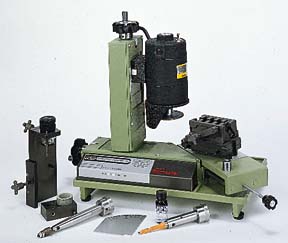Using a Sliding Table Saw to Rip Boards
Thoughts on using a sliding table saw for ripping, with a description of a slick jig that eases the work and improves the result. June 30, 2014
Question (WOODWEB Member) :
I've never used a long (eight to ten foot travel) slider table saw to rip lumber like you would on a conventional table saw (i.e. by pushing the lumber). It seems like it would be awkward, as you'd sort of be trapped by the sliding table projection to your left and couldn't get in a comfortable position to do a normal rip. So, to those of you that have actually done this is it awkward or not? Also, on some sliders, the means of moving the fence is on the outside left side which is great for panels using the slide but for conventional push rip seems like that too would present problems.
Forum Responses
(Solid Wood Machining Forum)
From contributor O:
We rip on our 10' slider fairly regularly and it just takes a little getting used to. The biggest challenge is trying to rip a 10"x10' board and not having much to table to support the piece as it enters the blade. On a regular saw this part is a non-issue.
From contributor B:
The slider table saw works just fine for this in my experience. Like the last poster mentioned, your biggest concern is supporting the material overhang.
From contributor M:
I rip/straightline on my slider almost daily. I made a right angle auxiliary fence that I clamp (quick clamps) to my slider rather than shoving the board across the blade with the conventional rip fence. I simply clamp this auxiliary fence to the slider and rip on the slider. Itís way more accurate, faster, increased and more consistent feed speeds, and so on which results in longer blade life. The increased feed speeds and no stalls in the feed while you re-position your hands makes for silky smooth cuts that are ready for glue-up. I use the flip stops on my slider to position the auxiliary fence and can tear through a pile of material way faster than with conventional rip and itís all dead straight (at 9.5' or shorter) when it comes off. My fence is just a piece of half inch poplar ply, 8' on the long edge, 4' or so on the short edge. Cut a radius on the diagonal to allow for a place to stand. A 1x2 or so on the fence edge for clamping and another on the long edge (slider length). I attached the long face fence with counter sunk screws then clamped it to the slider, raised the blade, and shoved it through. Dead parallel to the blade. Light weight, fast and handy.
From the original questioner:
ďI rip/straightline on my slider almost daily. I made a right angle auxiliary fence that I clamp (quick clamps) to my slider rather than shoving the board across the blade with the conventional rip fence. I simply clamp this auxiliary fence to the slider and rip on the slider. Itís way more accurate, faster, increased and more consistent feed speeds, and so on which results in longer blade life. The increased feed speeds and no stalls in the feed while you re-position your hands makes for silky smooth cuts that are ready for glue-up.Ē
Interesting idea. It would be great for certain lengths and widths. Still, with the Tiger Fence I'd probably be too lazy to set it up. Iím too used to typing in a number and hitting the start button. The ripping on a slider question came up because I now have a short slider where the slider ways project out very little so it's pretty much like ripping on a regular table saw. I was thinking about going with a longer slider and didn't visualize liking being trapped between the slider ways and the ideal stock push position too much.
From contributor M:
Yeah the Tiger fence is definitely sweet. I rarely use my rip fence for ripping (just the kind of work I do I guess). I tend to use it more as a stop but that too would be where a Tiger fence would shine in that there would be no walking around the slider to set the fence to the desired length of cut. I honestly canít think of the last time I did much ripping with the rip fence other than the rare instance where I have to rip long stock. I think a lot of it is just what type of work you do and what you get used to. For me thatís the main disadvantage of a slider that isnít automatic/programmable. There is a lot of walking to get around the tail end of the slider. That said, the benefits for me far outweigh that inconvenience. Plus I can use the exercise.
